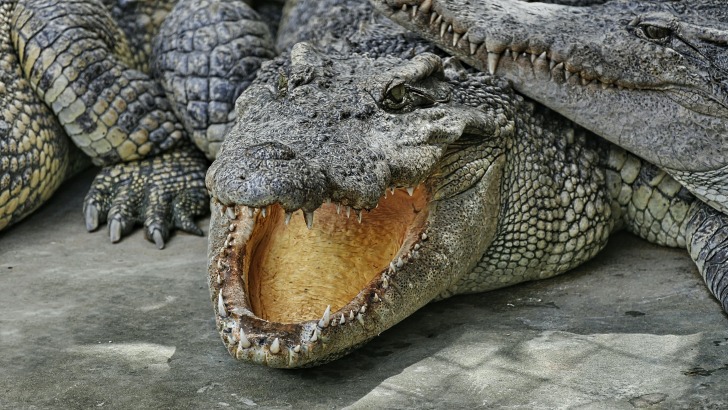Located on the Oklahoma – Texas border on the Red River, Lake Texoma is the 12th largest U.S. Army Corps of Engineers Lake and one of the largest reservoirs in the U.S.
The Denison Dam creates this lake and is located at the confluence of the Washita and Red Rivers.
Completed in 1944, Lake Texoma is five 15 miles southwest of Durant, Oklahoma, and five miles northwest of Denison, Texas.
It is the most popular and developed lake within the Tulsa District, with approximately six million visitors annually.
Although this lake is not located along the Gulf Coast, one of the questions about wildlife is, are there alligators in Lake Texoma?
Keep reading to find out!
Contents
So… Are There Alligators in Lake Texoma
Although alligator sightings are rare on Lake Texoma, they do occur occasionally.
However, you would need to be near the gator’s preferred habitat of marshy wetlands to see them.
Given the development of the lake over the years, gators tend to stay away from humans and stick to their wetland areas along the coastline.
Is it Safe to Swim in Lake Texoma?
Absolutely, Lake Texoma has numerous swimming locations and beaches during the summer months for visitors to enjoy.
However, there are some warnings that you should be aware of before going in the water, including:
Don’t Swim Without Lifeguards
You may be tempted to take a dip after the lifeguards have left for the day, but it’s best to hold off until they return during regular hours.
Although the lake is manmade, rip currents and other hazards are regularly present, so without a lifeguard, you could run into a bit of trouble on the lake and not have any assistance.
Distances Could be Further than they Appear
When swimming in Lake Texoma or any body of water, it’s critical to understand that distances are further than they appear.
Therefore, if you’re trying to swim between two distance points, have a buddy to avoid drowning if you can’t make it to the next location.
Judge Water Depth Before Diving
When diving into the water from any cliffs or rocky areas, ensure you are clear on the water depth and search for underwater obstacles before taking the plunge.
Diving into a rock or other obstruction can cause massive injuries.
Remain Clear of Boat Channels
Given the lake’s size, plenty of boats are on the water during the summer.
Therefore, if you plan to swim in the lake, it’s critical to remain clear of boat channels, such as docks and ramps.
Designated swimming areas are not close to these parts of the lake, so if you wander away from those sections, be on the lookout for boats.
Sun Exposure
Due to its location, Lake Texoma can become incredibly hot during the summer, with the sun beating down on visitors.
While you may feel cool by the comfortable lake waters, limiting sun exposure or reapplying sunscreen every 20 minutes is critical.
You are easily susceptible to severe burns when swimming without the proper protection.
In addition, prolonged sun exposure at Lake Texoma can result in skin cancer, so applying sunscreen should be a critical part of your visit to the lake.

Interesting Alligator Facts in Lake Texoma
The only species found in Lake Texoma is the American alligator, which is an interesting creature due to the following:
- Alligators can only live in freshwater lakes, which is why the wetlands along the coast of Lake Texoma are so appealing.
- Alligator jaws were designed to crush prey with up to 1,000 pounds of pressure per bite.
- Alligators open their mouths to release stored internal heat, similar to dogs, to bring down their body temperatures.
- Female alligators lay 30-40 eggs and incubate them for around 65 days during the mating season.
- Gators will fight each other to defend their young and territory.
- Many alligators enjoy sunbathing, so they can be found lying on rocks.
- The best time to spot gators in their natural habitat at Lake Texoma is in April, May, and June due to mating season.
- While scientists continue to study alligator diets, it has been confirmed that they consume fruit, which helps spread seeds around the local ecosystem.
Alligators vs. Crocodiles
If you ask the average person if they can differentiate alligators from crocodiles, most will say they know.
However, identifying one versus the other can be different if you don’t know what to look for since gators are part of the crocodilian family.
The best identifies include:
Behavior
Crocodiles are much more dangerous than alligators because they are opportunistic predators that are much more aggressive and attack anything that moves.
Crocs consider movement to be associated with prey, which is why they are more dangerous to humans than alligators.
Alligators are generally scared of humans and try to stay away, even in their habitat.
Alligators will only attack if they feel threatened or you are near their nest or offspring.
Color
Although color can sometimes be subjective, crocs are black, brown, grey, green, or a camouflage pattern to hide in the brush from prey.
Alligators are consistently dark green with small black receptor spots near the jaw that help detect ripples and water pressure when swimming.
Features
One of the biggest differentiating physical features between the two creatures is crocodiles have V-shaped snouts that can be wide or narrow, depending on the species.
Another defining feature is croc’s jaws close to the top, exposing their teeth.
On the other hand, alligators can be identified by their u-shaped snout with a jaw closing downward, thus only exposing the top teeth.
Habitat
Although crocs can live in wetlands and marshes, they prefer more saline waters.
Alligators exclusively live in freshwater habitats like swamps, wetlands, and marshes because their bodies don’t have the equipment to digest salt.
Crocodiles also require warmer temperatures than alligators, which can live in freezing lakes, and even hibernate in frozen lakes with their nose pointed out of the water.
Size
With males maxing out at around 23 feet, crocodiles are considerably large than their alligator counterparts.
The average American alligator’s length ranges from 15 to 17 feet, with the largest being around 20 feet.
Species
Although the number of species is not something that can be identified by looking at the creature, crocodiles have 13 species globally, and the alligator only has two: American and Chinese, with the ladder going extinct.
Teeth
Crocs feature sharper and pointier teeth that were designed to tear prey apart.
As mentioned, alligators have incredibly strong jaws to crush their prey.
Therefore, croc’s teeth don’t need to be as sharp, so they are cone-shaped.
The American alligator has up to 80 teeth at any time.
3 Safety Tips for Swimming in Alligator-infested Waters
Although alligators are more scared of humans than you are of them, it’s still important to take several precautions when swimming in Lake Texoma since you never know when you may come across a gator.
Three important points include:
Back Away Slowly if you Come Across a Gator
The first reaction of an alligator when they come across a human is to perform a quick retreat.
Suppose you come within a few yards of a gator; always back away slowly.
It’s incredibly rare for alligators to chase people, but don’t relate that reasoning to the creature being lethargic and slow because alligators are quick and agile.
Females will always protect their nests, and males will fight back if they feel cornered, so backing away slowly indicates that you are not a threat.
Don’t Swim in Areas with Tall Vegetation
Areas of tall vegetation along Lake Texoma are the ideal habitat for gators.
Therefore, if you’re swimming in the water and drift toward vegetation poking through the water, which is marshlands, calmly make your way back to the area where others are also swimming.
Never Let your Pets Swim Along the Shoreline
Don’t allow your pets to run or swim along the shoreline in marshy areas or those known to contain large populations of the creature.
Since dogs are usually the same size as an alligator’s natural prey, they could attack and chase your pet.
Summary
While alligators can be found as far north as Lake Texoma, it is incredibly rare to see them, even in their natural habitat, because they tend to move away from humans.
If you come across an alligator swimming in the lake, slowly move away and remember that they are more scared of you than them.
However, never underestimate their speed and agility, as they are much faster than humans.
Swimming in Lake Texoma is perfectly safe, but you want to ensure a lifeguard is always on duty and avoid boating areas if you drift too far away from the designated swimming locations.
Frequently Asked Questions
Which areas of Texas have alligators?
Alligators can be found in many lakes, rivers, marshes, and swamps in eastern Texas and as far north as Lake Texoma.
However, you won’t find them in West Texas due to the lack of water and the more arid climate.
Alligators seek more humid environments, which is why the gulf area and eastern part of the state are such attractive areas.
Which areas of Oklahoma have alligators?
Lake Texoma is the further north you will find alligators, so beyond this river basin, they are incredibly rare in Oklahoma.
While alligators can withstand freezing temperatures for short periods, further north in the state becomes incredibly cold for lengthy periods, which is not conducive to an alligator habitat.
You can find them in some other lakes around the state’s southern portion, but sightings are almost nonexistent, and these are much smaller gators than found along the Gulf Coast.
Are American alligators in Lake Texoma part of the crocodilian family?
Yes, alligators are members of the crocodilian family, along with Chinese alligators, caimans, and crocodiles.
How old is the American alligator?
Scientists speculate that the American alligator is approximately 150 million years old.
The species managed to avoid extinction when the dinosaurs died off around 65 million years ago.
How many alligators exist in Oklahoma?
Oklahoma is least known for its alligator population, but it is home to between 100 and 200 individuals.
It is considered a stable population that’s large enough to continue reproducing without exhausting areas of prey.











